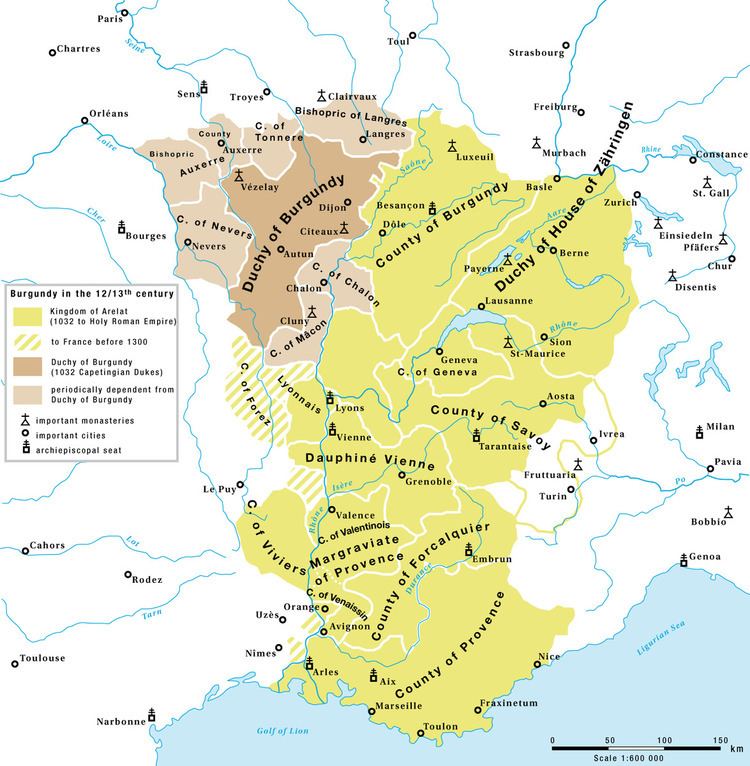 | ||
The following is a list of the kings of the two Kingdoms of Burgundy, and a number of related political entities devolving from Carolingian machinations over family relations.
Contents
Kings of the Burgundians
The Burgundians had left Bornholm c. 300 and settled near the Vistula. Jordanes relates that in this area they were thoroughly defeated by the Gepids in the 4th century and then moved to the Rhineland.
Flavius Aëtius moves the Burgundians into Sapaudia (Upper Rhône Basin).
Burgundy under Frankish kings
Gradually conquered by the Frankish kings Childebert I and Clothar I from 532–534
Merovingian kings
United with Neustria under one king, but with separate administration (613–751)
Carolingian kings
The sons of Louis the Pious divided the Frankish kingdom in the treaty of Verdun in 843. Burgundy was divided between the brothers
After Lothar's death in 855, his realm was divided between his sons. The Burgundian territories were divided between:
For the kings of Provence before its (re)union with the rest of Burgundy, see the list of dukes, kings, counts, and margraves of Provence.
Kingdom of Upper Burgundy
Lothar subsumed his portion of Burgundy into the Kingdom of Lotharingia and at his brother Charles' death, gained some northern districts of the deceased's kingdom. When Lothar II died in 869, his realm was divided between his uncles Charles the Bald and Louis the German in the Treaty of Mersen.
When Emperor Charles the Fat, who until 884 had reunited all Frankish kingdoms except for Kingdom of Provence, died in 888, the nobles and leading clergy of Upper Burgundy assembled at St Maurice and elected Rudolph, count of Auxerre, from the Elder Welf family, as king. At first, he tried to reunite the realm of Lothar II, but opposition by Arnulf of Carinthia forced him to focus on his Burgundian territory.
In 933 Rudolph ceded his claims to the Kingdom of Italy to Hugh of Arles and in return gained the Kingdom of Provence, thus reuniting the two territories.
In 1032 the Kingdom of Burgundy was incorporated into the Holy Roman Empire as a third kingdom, the Kingdom of Arles, with the King of Germany or Emperor as King of Burgundy.
Salian (Frankish) dynasty
Supplinburger
Staufen (or Hohenstaufen dynasty)
Rectorate of Burgundy
Under the kings Conrad I and Rudolph III, royal power had weakened while local nobles, such as the counts of Burgundy, had gained prominence.
After the early death of Emperor Henry III, his widow Agnes of Poitou acted as Regent for his young son Henry IV. She made Rudolf von Rheinfelden duke of Swabia and also conferred on him the regal powers over Burgundy. However, when Rudolf was elected anti-king, Roman king Henry IV in 1079 stripped him of his powers and delegated them to the Prince-bishops of Lausanne and Sitten (both in present Switzerland).
When William III, Count of Burgundy was assassinated in February 1127, King Lothar III supported the claims of William's uncle Duke Conrad of Zähringen, grandson of Rudolf von Rheinfeld to the countship and conferred on him the regal powers over Burgundy.
Lacking a proper title, the Zähringer called themselves dukes and rectors of Burgundy, in order to gain the status of dukes of Burgundy. The royal chancellory however consistently avoided this term and the effective power of the rector (in Roman law, a generic term for provincial governor) was restricted to the possessions of the Zähringer east of the Jura.
Any attempts to enforce the Zähringer's claims and to extend royal authority into the western and southern parts of the kingdom failed, most notably a military campaign in 1153. After these failures, Emperor Frederick I Barbarossa, gained a firm hold of the western districts in 1156 by marrying Beatrice, heiress to the countship of Burgundy. This success permanently confined the Zähringer between Jura and Alps, where they used their regal powers to expand their possessions. In 1218, Berthold V, Duke of Zähringen died without issue.
After this, King Frederick II conferred the title of the rector of Burgundy on his young son Henry, in order to keep the heirs of Zähringer possessions away from the regal powers associated with that title. This appointment was only of momentary importance and after Henry had been elected King of Germany in April 1220, the title disappeared for good. Also, the decline of royal power inside the kingdom of Burgundy remained irreversible.
